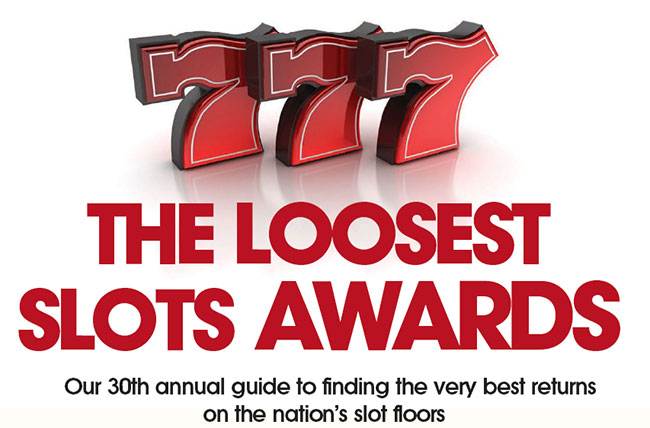THE LOOSEST SLOTS AWARDS
By Frank Legato
Longtime readers of this magazine and our sister publication Casino Player have always been on the hunt for the loosest slots on the floor. In fact, Player was the first publication to use the term “loose slots” in reference to slot machines that offer a liberal payback percentage, known these days as return-to-player percentage, or RTP.
As you may know, Casino Player, the original publication for casino enthusiasts, began publishing in 1988, a time when slot machines were the hot new thing. It was the first great surge of slot popularity, which would see slot machines surpass table games as the biggest money- maker for the casinos.
A few years later, the magazine began publishing the “hold” percentages casinos are required to report publicly. These percentages, released monthly by regulatory authorities, show the percentage of all wagers on slot machines that is held by the casino; it also is known as the casino’s “win” from the players.
Casino Player began publishing charts of statistics that reversed the casino hold to show how much the players won from the casinos. In 1994, the magazine gathered all the statistics for a year and published the first “Loosest Slots Awards.” Casinos were delighted to be recognized as having “loose slots,” and began throwing their awards up on billboards. They still do.
Our readers, meanwhile, can be confident that an entire year’s worth of statistics demonstrates an accurate picture of how player-friendly each casino or casino region is. Even the monthly charts in the back of this magazine can contain information skewed by short-term results. It’s not uncommon to see high-denomination slots returning more than 100 percent of wagers to players in a single month, after a casino was slammed by high-end play.
Anything can happen in the short term. A year of numbers tells the whole story. As the charts invariably reveal over time, though, payback percentages in general have been stagnant for years. Returns to players dipped after the 2008 national recession, and have stayed at the lower numbers. The problem was aggravated by the Covid-19 pandemic and shutdowns.
That means it’s more important than ever to know where to find the right paybacks. That’s where the Loosest Slots Awards come in.
Casino Player started gathering statistics on payback percentage back in the early 1990s. Public information on monthly slot “hold”—that is, the portion of wagers held by the casino—were available, often broken down by denomination. In the early days of Player, the editors began taking those statistics and flip-flopping them to show the overall payback percentages of slots, by casino or by region, however it was broken down by each jurisdiction. Those are the charts you find in the back of this publication.
Casino marketing departments soon caught on, with advertisements referring to high-paying slots as “loose.” Casino Player decided to gather the statistics for an entire year, and in 1994, published the first “Loosest Slots Awards.” The awards, which seven years ago moved over to Strictly Slots, had a great effect for the benefit of players. Casinos wore their Loosest Slots awards as a badge of honor—and prime marketing point.
Slot machines come from the factory with a program that reflects a theoretical payback percentage. There are several payback programs, verified through computer simulation, available to slot officials. Statistics have shown that once in place over perhaps two to three months, the vast majority of slot games match their theoretical percentages with actual statistics.
Those statistics, presented here, will tell you with accuracy which casinos or casino regions are the most player friendly.
This year’s Loosest Slots Awards mark a milestone: It is our 30th annual installment. This report is based on hold/payback statistics logged over the 2023 calendar year. Before we get to the winners, we always like to provide answers to the most-frequently asked questions about our report.
First of all, not all casinos are included in this report. We are restricted to reporting on the statistics that are publicly available, and for the most part, that includes all commercial casinos and many of the largest Native American casinos. Because many Indian casinos are not required to report payback percentages to state regulatory agencies, some tribal casinos consider the statistics proprietary information, and do not report them publicly.
Two years ago, the state of Illinois stopped publicly reporting slot percentages. This is why Illinois casinos are no longer included in the report.
Our apologies if your favorite casino is not included.
Next, we are only able to report the numbers that are reported by the casinos. That is why you will not find denominations broken out in many locations—such as New Jersey, where regulators stopped reporting separate denominations eight years ago.
Finally, the way the numbers are reported publicly is the reason video poker paybacks are not broken out in this report. No jurisdiction reports separate numbers for slots and video poker. However, you’ll find that the casinos with the highest overall paybacks consistently offer the highest-returning pay schedules on video poker.
And The Winners Are…
For the third year running, the award for Loosest Slots in the U.S. goes to Nassau OTB at Resorts World New York City in Queens. This year, its 1,000 machines returned an astounding 97.36 percent, just about the same as the last two years.






